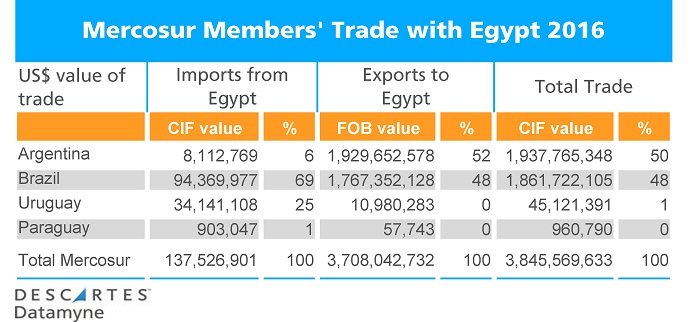With Argentine Congressional approval, the free trade agreement signed by trade bloc members and Egypt in 2010 will enter into force within a month.
Argentina announced it has sent its formal ratification of the Mercosur-Egypt FTA to the regional trade bloc’s headquarters in Asunción, Paraguay.
Implementation of the FTA will begin in 30 days. Tariffs on 60% of exports in the categories of food, automobiles and auto parts, products for the extraction of hydrocarbons, chemicals and agricultural machinery will end immediately. Remaining tariffs will be phased out over 10 years.
The trade pact was signed by Egypt and Mercosur members Argentina, Brazil, Paraguay and Uruguay seven years ago. Ratified by all the other signatories, the FTA’s formal ratification by Argentina had to wait on Congressional approval, granted May 9th of this year.
“Es una muestra que Argentina volvió al mundo [It is a sign that Argentina has returned to the world],” Argentina’s Commerce Secretary Miguel Braun said.
It is also a sign that a shift in policy to expanding trade relations, announced earlier this year by the presidents of Argentina and Mercosur partner Brazil, is gaining traction.
Another encouraging signal was sent by European Union (EU) Trade Commissioner Cecilia Malmström who said earlier this month that the EU bloc “hopes to announce a political agreement for this Christmas in Buenos Aires.”
Our global trade data ranks Argentina and Brazil 9th and 10th among Egypt’s trade partners by value of trade in 2016. As the data table below shows, Mercosur’s two leading members account for almost all trade between the bloc and Egypt, with both exporting far more than they import.
Uruguay’s and Paraguay’s trade with Egypt is on a smaller scale.
Our first-quarter 2017 data shows a surge in imports from Egypt by Brazil and Uruguay, compared with the same period a year ago. Meanwhile exports to Egypt appear to be lagging for every Mercosur member except Paraguay, which posted no exports at all.
We’ll revisit the data after the Mercosur-Egypt FTA takes effect.
It should be noted that these trends in their trade with Egypt do not reflect the Mercosur member countries’ overall positive growth in exports in first-quarter 2017, as this chart shows:
Related:
- Download our free report Quick Look @ Mercosur Trade in 2016 for stats on each member’s top imports and exports, top markets and countries of origin, and top regional trade partners, based on our Latin American trade data.
- From our blog: Actively Seeking Trade Ties | Mercosur
- Learn more about our Latin American import-export data.





